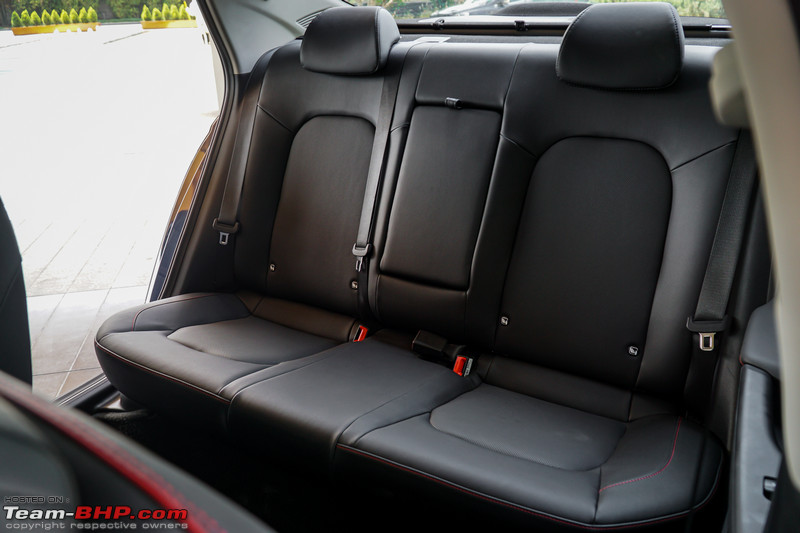| |||||||
| Search Forums |
| Advanced Search |
| Go to Page... |
 |
| Search this Thread |  895,185 views |
| | #1 |
| Team-BHP Support  Join Date: Apr 2016 Location: Mumbai
Posts: 1,813
Thanked: 21,569 Times
| 2023 Hyundai Verna Review 2023 Hyundai Verna ReviewHyundai Verna Pros• An all-rounder sedan that ticks all the right boxes • Well-positioned overall package. Priced competitively against rivals • User-friendly interiors with good cabin space • 158 BHP, 1.5L turbo-petrol engine is the most powerful in the segment. Gets a quick DCT too • Comfortable, neutral suspension setup riding on 205/55 R16 tyres • Long list of features includes LED auto headlamps, ventilated seats, electric driver’s seat, sunroof, wireless charging, smart trunk, rear sunshade & more • 5-star Global NCAP rating. Safety equipment includes level 2 ADAS tech, 6 airbags, ESC, 3-point seatbelts for all, rear disc brakes, front & rear parking sensors etc. • Hyundai's wide service network & up to 7-years extended warranty Hyundai Verna Cons• Futuristic styling will polarise opinions. Many BHPians think the design is too edgy & unusual • Better quality plastics should’ve been used in a car that costs 20+ lakh on-road • No diesel engine on offer. Outgoing Verna was the last diesel sedan in the segment • Turbo-petrols are very sensitive to driving style. FE will drop drastically when you drive hard • Dual-clutch ATs have a history of poor reliability in India. Note: Verna with 1.5L NA CVT is available • Back seat is more suitable for 2 healthy adults and a child. Not 3 healthy adults • Not as much fun-to-drive as the VW Virtus & Skoda Slavia • Missing features like a 360-degree camera, wireless Android Auto & Apple CarPlay, auto wipers and foldable rear seat (a must in sedans IMHO) IntroductionIf you are a car manufacturer who wants to sell a sedan in today’s market, you really need to have something special to offer. Hyundai sure thinks that their all-new Verna is that car. The C2 segment sedan has been a consistent performer for Hyundai in the past and now, a new generation of the sedan has been introduced in the country. Competing against the likes of Honda City, Maruti Ciaz, Skoda Slavia and the Volkswagen Virtus isn’t going to be easy, but the new Verna sure seems to have a lot of things going for it to become the segment leader. Powering the new Verna are two petrol engines – a 113 BHP, 1.5-litre naturally aspirated (NA) petrol and a 158 BHP, 1.5-litre turbo-petrol. Both engines are offered with 6-speed manual transmissions, while you get the option of a CVT automatic with the NA petrol and a 7-speed DCT with the turbo petrol. Thanks to the RDE norms, the diesel engine has been dropped. Now that it’s a level playing field and all the cars in this segment have only petrol engines, it will be interesting to see the sales charts in the coming months. Hyundai Verna Price & BrochureBroadly speaking, the Verna is priced between the Ciaz and the others (Honda City, Skoda Slavia & VW Virtus). It’s available in four variants: EX, S, SX and SX (O) with prices starting at Rs. 10,89,900 (ex-showroom) – click here for the full price list. Comparing the top-end turbo-petrol variants, the Verna undercuts the Skoda Slavia and Volkswagen Virtus by almost a lakh. However, Skoda probably seems to have been waiting for the Hyundai's launch because they just announced that the Slavia's 1.5 turbo-petrol (TSI) will also be available in the Ambition (mid) variant (related News). This move is directly aimed at the SX variant of the Verna. The 1.5L naturally aspirated variants of the Verna are priced at par with the Honda City. However, we feel that Hyundai could’ve priced the Verna more aggressively to pull away some customers from the Honda. You can download the Hyundai Verna brochure here - 2023 Hyundai Verna Brochure.pdf Design & StylingHyundai’s latest global design language isn’t something you will appreciate at first glance. It’s edgy, futuristic and in today’s terms, really out there. But the earlier designs, both exterior and interior, were starting to feel outdated and too conservative. So in a way, this new direction should work well for Hyundai in the long term. Even among BHPians, new Verna’s design polarised opinions. While in pictures, some of the exterior details might look overdone, in person, the car doesn’t look that outlandish. There are plenty of creases on the body which add some character to the car. The Verna has grown in size compared to the outgoing car. The new car measures 4,535 mm in length (+95 mm), 1,765 mm in width (+36 mm), and 1,475 mm in height. The wheelbase has also gone up by 70 mm and now measures 2,670 mm. Build Quality, Fit & FinishBased on an all-new platform, the Verna sure feels well-built. The panel gaps are tight and we didn’t find any uneven gaps on our test car. There’s some flex in the panels, but it doesn’t feel like it's lightly built. The doors have a good heft to them and close with a reassuring thud. The bonnet feels heavy and the overall finish of various design elements on the outside is pretty good. Wheels & TyresThe top-end turbo-petrol variants are equipped with 16-inch black alloy wheels shod with 205/55 section tyres. This size is similar to the Slavia and Virtus. The non-turbo top-end variants get the same size, but the alloys are dual-tone diamond cut rims. The lower "S" variant gets smaller size 15-inch alloy wheels with 185/65 section tyres. The spare is a 15-inch steel wheel with a 185/65 section tyre. Ground ClearanceHyundai hasn’t revealed the exact ground clearance number for the Verna. It’s similar to most of the sedans in the segment and over some uneven patches the Verna didn’t scrape. Standard & Extended WarrantyWith the Hyundai Verna, you get a standard warranty of 3 years / unlimited km. You can also get an extended warranty of up to 7 years and we strongly suggest taking it. MaintenanceHyundai offers various maintenance packages for up to 5 years. As a part of Hyundai Shield of Trust, the package covers major running parts like brakes, clutch, wipers, belts, etc. There’s also an additional Super package which further reduces the maintenance costs. It comes with inflation protection against the increase in parts prices and labour rates. The service interval is 1 year / 10,000 km. SafetyThe Hyundai Verna was awarded a 5-star rating by Global NCAP. On the features front, Hyundai has made sure that all the bases are covered. The car comes equipped with level 2 ADAS features with front and rear radar sensors. This means that you have all sorts of driver assistance features like forward collision avoidance assist, blind spot warning, lane keep assist, safe exit warning, adaptive cruise control, rear cross-traffic collision assist, etc. You also get 6 airbags as standard, ESC, ABS with EBD, front and reverse parking sensors, TPMS, hill-start assist, ISOFIX child seat anchors, auto headlamps (no auto wipers though), 3-point seatbelts for all passengers and rear disc brakes (only in turbo-petrol DCT). Last edited by Omkar : 23rd October 2023 at 12:34. |
| |  (80)
Thanks (80)
Thanks
 |
| The following 80 BHPians Thank Omkar for this useful post: | @Debanshu_B, adityan27, aeroamit, AheadAJ, Akshay6988, ashivas89, CarWorld, CEF_Beasts, CentreOfGravity, Chaman K, Chetan_Rao, chinmaypillay, Chrome6Boy, dailydriver, denzdm, digitalnirvana, Dr.AD, espraveen, frankmehta, GaryTSI, Gibence, GTO, g_sanjib, Harjot37, hellraiser_yank, InControl, irajput, Jeash.vk, keroo1099, libranof1987, Livnletcarsliv, lovetorque, Mustang Sammy, N33raj, naadopaasaka, Nagesh Bhatt, NitNac, Osteon206, Peri_patetic99, PGNarain, PM - B, pmbabu, Potenza, Pr4mod, prash1892, PrasunBannerjee, Raghu M, RakishRam, RavenAvi, RBR, Revention, rGT, rj22, rkv_2401, RohaNN_kWh, Rshreyansh, S.MJet, Samba, Samfromindia, sanjayrozario, SanjayW, SatishBisht, shancz, Shanks_Jazz, shivraj737, Shreyas Aterkar, Simhi, slango97, stringbh, Swarup5, swiftnfurious, The Rationalist, theexperthand, thiagar, vaasu, vb-saan, Voodooblaster, vredesbyrd, YashD, yosbert |
| |
| | #2 |
| Team-BHP Support  Join Date: Apr 2016 Location: Mumbai
Posts: 1,813
Thanked: 21,569 Times
| Cabin Design & QualityStep into the cabin and you are greeted by a premium-looking dashboard. You have plenty of sleek components that lend a futuristic look to the cabin. However, unlike the exterior where the design might polarise opinions, the interior design is very much likeable. The turbo-petrol variants get an all-black dashboard with red accents, while the naturally aspirated variants get dual-tone black and beige interiors. Both colour schemes look good in the car, and they reflect the character of the engines well. The quality of materials used in the cabin is where things could’ve been better. While the build quality is satisfactory, you will mostly find hard plastics used in the cabin. Something that might put off some buyers is that these are scratchy plastics. This is not something you would expect in a car that will cost ~20+ lakhs on road. You do get a layer of leatherette in the middle running across the dashboard which feels nice. Space & ComfortIn terms of dimensions, the Verna is wider than its competitors and also has the longest wheelbase in the segment. This translates into better cabin space. The front passengers are seated at a comfortable distance from each other and with the glass area on offer, the cabin feels airy. The front seats are draped in leatherette upholstery and offer good overall support. The cushioning is on point and felt comfortable throughout our test drive. Under-thigh support is good, and you get healthy bolstering on the seat base as well as the backrest. The driver seat gets 4-way electric adjustment with manual height adjustment. The doorpads have leather-wrapped armrests and there’s also a centre armrest. All in all, the front seats are quite comfortable. Driving Position & ErgonomicsInside the cabin, you will find most of the controls quite intuitively and you won’t be actively searching for any controls. Even in terms of ergonomics, all the controls are placed within easy reach. Only the window controls, I felt, were placed a little further ahead than usual. Reminded me of the Fiat Punto, in which, if you’d want to roll down the driver window, you ended up operating the rear passenger window. In the Verna, you get a 2-spoke, leather-wrapped steering wheel that’s adjustable for height and reach, though it does take some effort to pull the steering towards you and it’s not smooth. The steering also has very usable thumb contours and the hornpad is also easy to reach. The paddle shifters are convenient to use as well, but we wished the paddles were bigger in size like in the i20 N-line. Cabin StorageThere's a good amount of storage space inside the cabin and most of your things will find their way to one storage space or the other. There’s a decently-sized ventilated glovebox to start off with. Then you have the doorpads which can accommodate two 500 ml bottles (wonder why they didn't offer just one big 1-litre bottle holder?) and some other knick-knacks. In the turbo-petrol DCT variant, you get an electronic parking brake which frees up a lot of space in the centre console. Hence, compared to the variants with a manual parking brake, you get a bigger cubbyhole with a retractable cupholder and also a bigger storage box underneath the centre armrest. The rear passengers also get seatback pockets to keep their stuff. Air-ConditioningThe Verna gets a fully automatic temperature control unit that cooled the cabin quite effectively on a hot day in Gurugram. An added bit of comfort was provided by the super effective ventilated seats, which made things even better. The air-conditioning comes with an integrated air purifier as well. FeaturesUnique & Noteworthy FeaturesIn today’s day and age, features are very important and the Verna comes loaded with quite a few of them. You get a 10.25-inch touchscreen infotainment unit with Android Auto and Apple CarPlay connectivity and 'BlueLink' connected car tech for which you get a 3-year subscription free with OTA (over-the-air) updates. Apart from these, you get a wireless phone charging pad, ventilated and heated front seats, ambient lighting, rear A/C vents, smart trunk release, auto start-stop and a manual rear sunshade. What you do miss out on is rain sensing wipers, wireless Android Auto and Apple CarPlay, a 360-degree camera system and a foldable rear seat. Audio System & Sound QualityThe top variant gets a 10.25-inch touchscreen infotainment unit with onboard navigation and an 8-speaker Bose audio system. While you don’t get the typical physical buttons like the previous car, Hyundai has sleekly integrated the A/C controls and infotainment controls in the panel below the central A/C vents. These are touch-operated and not physical buttons, but can be used to directly jump to menus instead of looking for them on the home screen. Even otherwise, the touchscreen has a pretty straightforward layout and is user-friendly. There’s no lag and it feels slick. Even the display is clear and crisp and you can read the screen under direct sunlight without any problem. Audio quality expectations will be high considering that this is an 8-speaker Bose sound system. However, we’d suggest keeping your expectations low as the system doesn’t impress you outright. Even after playing around with the settings, it doesn’t feel as punchy and the vocals sound a little flat as well. In comparison, the VW-Skoda system sounded better, but not by a huge margin (since Skoda removed the subwoofer from the Slavia). Rear Seat Comfort & SpaceWith the longer wheelbase, the focus has been on increasing the space in the rear. Compared to the older car, Hyundai claims that the rear passengers get 25 mm more shoulder room, 93 mm more knee room and 120 mm more leg room. The Verna does, in fact, feel more spacious and comfortable in the back compared to the old car. Getting in and out isn’t that difficult, but you have to mind your head. Like most sedans, you have to sit down in the seat rather than slide in. The seat cushioning is on point like the front seats and passengers should be comfortable over long journeys. However, while the rear bench gets 3-point seatbelts for 3 passengers, seating 3 adults abreast isn’t very comfortable. It’s better if the third passenger is a child and not an adult. In terms of comfort, at 5’10”, I had enough space in the rear seat with the driver seat set in my driving position. There was decent knee room and some space under the front seat to tuck my feet into. But in terms of sheer space, the Honda City is better. In the Verna's backseat, I did feel that the under-thigh support could’ve been better. Shorter folk will find it comfortable though. Thanks to the sloping roofline, the headroom did feel tight. Occupants over 6 feet tall would have their heads brushing against the ceiling. The backrest is set at a comfortable angle and despite the headrest having a very small adjustment range, it’s quite comfortable to use. Rear occupants get A/C vents and two USB-C charging ports. Boot SpaceThe new Verna has a boot space of 528 litres which is 48 litres more than the outgoing car. In fact, it has the largest boot in the segment. However, like the old Verna, you cannot fold down the rear seats to expand the luggage capacity or carry long objects. You can do so in the Virtus and Slavia. Hyundai also claims that the boot opening is now wider by 41 mm for easier loading and unloading of luggage. Last edited by Omkar : 31st July 2023 at 10:20. Reason: Typo. |
| |  (64)
Thanks (64)
Thanks
 |
| The following 64 BHPians Thank Omkar for this useful post: | aeroamit, AheadAJ, Akshay6988, akshay81, ashivas89, CEF_Beasts, CentreOfGravity, Chetan_Rao, chinmaypillay, dailydriver, digitalnirvana, Dr.AD, espraveen, frankmehta, GaryTSI, getsurya, Gibence, GTO, g_sanjib, hellraiser_yank, InControl, irajput, Jeash.vk, keroo1099, libranof1987, Livnletcarsliv, Mach_1590, Meph1st0, Mustang Sammy, N33raj, naadopaasaka, Nazaar25, NitNac, Peri_patetic99, PM - B, Potenza, Pr4mod, prash1892, PrasunBannerjee, raptor_diwan, RavenAvi, rj22, rkv_2401, RohaNN_kWh, Roy.S, Rshreyansh, S.MJet, Samba, Samfromindia, sanjayrozario, SanjayW, SatishBisht, shancz, Shanks_Jazz, Shreyas Aterkar, Simhi, stringbh, The Rationalist, theexperthand, thiagar, vaasu, vb-saan, yesyeswe, yosbert |
| | #3 |
| Team-BHP Support  Join Date: Apr 2016 Location: Mumbai
Posts: 1,813
Thanked: 21,569 Times
| Driving the Hyundai Verna 1.5L Turbo-Petrol DCT Automatic1.5L, 4-cylinder turbo-petrol engine makes 158 BHP @ 5,500 rpm and 253 Nm @ 1,500-3,500 rpm:  The previous generation Verna came with a 118 BHP, 1.0-litre turbo petrol engine that didn't find a lot of buyers. This time around, since the Volkswagen - Skoda twins have powerful turbo-petrols, Hyundai decided to plonk a bigger engine in the Verna. The 138 BHP, 1.4-litre Kappa turbo-petrol engine from the Creta made perfect sense, but that had to be upgraded to meet the emission norms. The result is this Smartstream 1.5-litre turbo-petrol engine which still belongs to the Kappa family and makes an impressive 158 BHP and 253 Nm. These are the highest numbers in the segment. The claimed 0-100 km/h time is 8.1 seconds, which is a good indicator that the Verna is F-A-S-T. Fire up the engine, and it's refined like a typical Hyundai, silently purring away. Hyundai powertrains have always set NVH benchmarks, and this car is no different. Shift to D or R, and it crawls away smoothly. Crawling at city speeds isn’t very dramatic and the 1.5L is very well-behaved. With light to medium throttle inputs, you can go about your daily commute quite comfortably. In comparison with the old 1.4L turbo-petrol in the Creta, the throttle response is smoother and power delivery is more linear. The 7-speed dual-clutch transmission is also seamless moving through the initial gears. However, we did notice that the gearbox got a little confused on a few instances while driving through some traffic. The engine has a healthy bottom end and thanks to a turbocharger and direct injection, you’re never in a shortage of power. Just floor the accelerator if you want to close a gap in traffic or make that quick overtake and the engine and gearbox will do the rest. Get on some open roads and you can let the Verna stretch its legs. Put down your right foot and before you know it, you’ll hit the highway speed limit of 120 km/h. This is the thing with turbo-petrols - flooring the throttle on an empty stretch of road can get addictive. Outright acceleration is great and it feels a little more linear as well compared to say, the 1.5 TSI from the VW-Skoda cars. The turbo delivers a strong mid-range punch that will take care of all the overtaking on the highway. You can cruise along the highway at 100 km/h while the engine spins at a relaxed 1,800 rpm. Even at 120 km/h on the Delhi-Mumbai expressway, the engine felt relaxed with the rev counter reading 2,200 rpm. The Verna won't break a sweat cruising at these speeds all day long. The dual-clutch transmission moves through the gears quite seamlessly. The kickdown response time is quick enough and the gearbox doesn’t hesitate to drop down 3 or even 4 gears at times to get the engine into the powerband. When you are in the mood for some fun in the ghats, switch to Sport mode and start flipping the paddle shifters for manual control. The ECU matches the revs and you’ll hear the sweet note of the engine. Yes, IMO, the engine sounds nice and sporty at high revs. Although Hyundai has restricted the maximum rpm to 5,900, which is too low, at least the engine sounds great as it reaches that number. The paddle shifters are responsive and you can extract some performance from the engine using them for quick overtakes or keeping the engine in the powerband over some twisties. There is also an “S” mode which makes the transmission more aggressive. This mode can be engaged by moving the gear shifter to the right. However, the gearbox logic in the Virtus and Slavia 1.5 DSG is better and more in tune with the requirements of the driver. The Verna gets 3 drive modes - Eco, Normal and Sport. Eco Mode - Engage the Eco mode when you want to extract maximum fuel efficiency. The throttle response is dulled, but given the power on tap, the mode is quite comfortable to use in the city. In fact, we preferred driving in this mode in the city as the car becomes a lot smoother to drive. The Auto Start-Stop feature is activated automatically when you select the Eco mode. Normal Mode - This is the default mode and just as the name suggests, it's normal to drive. The difference between Normal and Eco modes is very little. Sport Mode - Engage this mode when you want the car to be more responsive to your inputs. The throttle response is sharper and the transmission also holds on to gears a bit longer in this mode. The steering is also noticeably heavier, although not as much as enthusiasts would like (more on this later). The Sport mode isn't something you'd want to engage in the city as it can get a bit jerky to drive. Noise, Vibration & Harshness (NVH)The 1.5-litre unit is very refined overall. At city speeds as well as while cruising at 100 km/h, you can barely hear the engine in the cabin. Even the vibrations are well controlled and cruising with the family on the highway should be comfortable. Road noise from the tyres does creep into the cabin at highway speeds, but the wind noise is kept well in check. The engine has a sporty note to it at high revs. Mileage & Fuel economyThe Verna comes equipped with an Auto Start-Stop feature that helps fuel efficiency in city driving conditions. The ARAI-certified fuel efficiency for the 1.5-litre turbo-petrol DCT is a whopping 20.6 km/l and that for the 6-speed MT is 20 km/l. Of course, the real-world FE numbers will be much lower considering that turbo-petrol DCTs are very sensitive to the driving style. We’ll wait for some ownership reviews to get a better picture of real-world fuel efficiency. Ride ComfortThe Verna gets a McPherson strut suspension at the front and a torsion beam axle at the rear. Higher variants are equipped with 16-inch alloy wheels shod with 205/55 section tyres. Like most Hyundais, the Verna is tuned for comfort and has an absorbent ride. The slow speed ride is comfortable and will be appreciated by most people. The suspension also works very silently in absorbing small bumps and potholes. Big potholes do register themselves in the cabin. There’s some body movement felt in the cabin over bad roads, but it doesn't get very uncomfortable. Handling & DynamicsThe previous generation Verna and some of the older Hyundais were notorious for feeling floaty at high speeds. The new Verna has improved in this regard to an extent. At high speeds, the car is stable and feels very steady cruising at 100-120 km/h. That said, there’s still a bit of vertical movement at high speeds while going over bumps and expansion joints - it takes a couple of bobs before settling down. When we talk about the dynamics of the car, understand that the Verna is softly sprung. This doesn’t really translate to good handling characteristics and is a stark contrast to the sporty nature of the engine. Get to a corner and the turn in is sharp as the heavy front end keeps the nose planted. You can guide the car into the corner well, but then, you are met with a good amount of body roll. Carry some extra speed and you will encounter some understeer as well. Change directions from one corner to another quickly and you can actually feel the whole weight transfer happening behind you. Under most driving conditions on roads, the car will hold its line well. However, the chassis doesn’t really complement the powerful engine and enthusiasts will be looking for some stiffer springs as their first upgrade. In comparison, the Skoda Slavia and Volkswagen Virtus despite being less powerful, offer a lot more for enthusiasts when it comes to handling and dynamics. 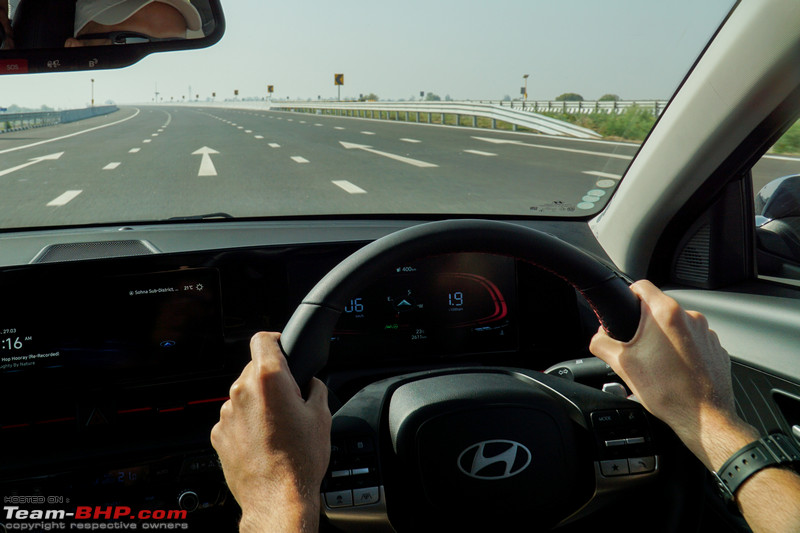 SteeringThe EPS is light and user-friendly at parking and city speeds. It’s something you would expect from a Hyundai. For driving around in the city and occasional highway trips, this steering is just perfect. It weighs up adequately on the highways and there’s little vagueness in the centre. However, from an enthusiast's perspective, there’s nothing on offer. It feels very disconnected and light even at high speeds and in Sport mode. BrakingOnly the top turbo-petrol variant with the DCT gets all-wheel disc brakes. All other variants, including the turbo-petrol manual, get drum brakes at the rear. The stopping power from the all-wheel disc brake setup is good and we didn’t find any issues during our test drive. The pedal also feels good to use and has a progressive feel to it. Niggles & ProblemsHyundai isn’t a company you associate with poor reliability and bad after-sales. However, while most of the recent feedback has been positive, the turbo-petrol engine with the dual-clutch transmission is something you should be careful with. Early owners of the Creta & Seltos 1.4 turbo-petrol DCT did face some gearbox overheating issues. While most of them have been resolved, it’s very much advisable to go for the maximum extended warranty of 7 years. Don’t even think about it twice, it’s better to be safe than sorry. Last edited by Omkar : 17th January 2024 at 12:00. |
| |  (77)
Thanks (77)
Thanks
 |
| The following 77 BHPians Thank Omkar for this useful post: | 2himanshu, AheadAJ, Akshay6988, AROO7, ashivas89, CEF_Beasts, Chetan_Rao, chinmaypillay, Chrome6Boy, dailydriver, digitalnirvana, Dr.AD, espraveen, fluidicjoy, GaryTSI, gauravanekar, getsurya, Gibence, GipsyDanger, GTO, gunin, Harjot37, hellraiser_yank, Herschey, InControl, irajput, Jeash.vk, keroo1099, libranof1987, Livnletcarsliv, lovetorque, Mustang Sammy, myavu, naadopaasaka, Nazaar25, NitNac, Osteon206, Peri_patetic99, PGNarain, ph03n!x, PM - B, pms, Potenza, Pr4mod, prash1892, PrasunBannerjee, PWRUP, RaceCyborg, RavenAvi, Rigid Rotor, rj22, romil.shroff, Roy.S, Rshreyansh, S.MJet, Samba, Samfromindia, sanjayrozario, SanjayW, Sen, shancz, Shanks_Jazz, Shreyas Aterkar, Silverfire, Simhi, stringbh, swiftnfurious, The Rationalist, theexperthand, TkyoPandaMan, vaasu, vb-saan, vishal.jayakuma, Voodooblaster, Xaos636, yosbert, zorori47 |
| | #4 |
| Team-BHP Support  Join Date: Apr 2016 Location: Mumbai
Posts: 1,813
Thanked: 21,569 Times
| Hyundai Verna Exterior ImagesEdgy, futuristic and over the top are some of the adjectives to describe the front end of the new Verna. Aggressive face with the bonnet sloping down towards the wide trapezoidal grille. Some may like it, and some won’t:  Rear is more subtle compared to the front. You still have some details that stand out, but overall, not something that will offend most people:  More of a fastback-like silhouette than a typical 3-box sedan design, but have to say, the car looks so good in profile! The proportions are just right and the elements on the body somehow manage to gel well with the design:  Edgy design may not be for everyone, but in person, it doesn’t look that bad. Lots of creases give it a muscular look:  The Verna measures 4,535 mm in length, 1,765 mm in width and 1,475 mm in height with a wheelbase of 2,670 mm, which is the longest in the segment:  Twin-pod LED headlamps are integrated into the grille. Turn-indicator is placed just below the headlamp inside the grille. Bumper features vents on the side (air curtains) that direct air into the wheel wells:  Big trapezoidal grille is finished in glossy black and the bumper gets an air dam above the grille on the turbo-petrol variants (NA variants don't get the air dam). LED DRL strip runs across the front. The middle portion of the LED strip can be turned off if that’s what you prefer. Radar sensor is placed just below the number plate:  Healthy amount of underbody protection at the front:  Camera for the ADAS features is placed at the top of the windshield:  ORVMs have a sleek design and integrated turn indicators. The upper part is body coloured:  You’ll find a "DCT" badge only on the right fender: 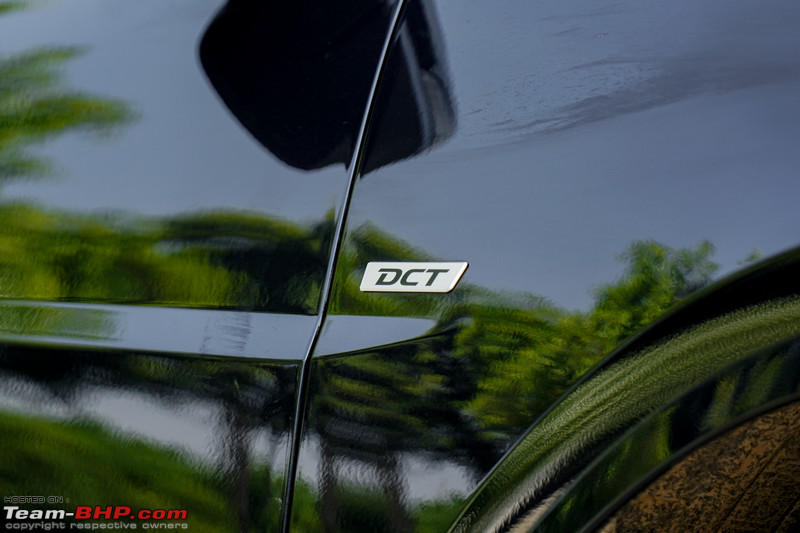 Satin grey door handles look out of place IMO. Should’ve been body coloured. Only the driver-side door gets a request sensor and keyhole:  16-inch black alloy wheels have a busy design. It looks like two 5-spoke designs have been laid over each other. Front brake discs get red calipers: 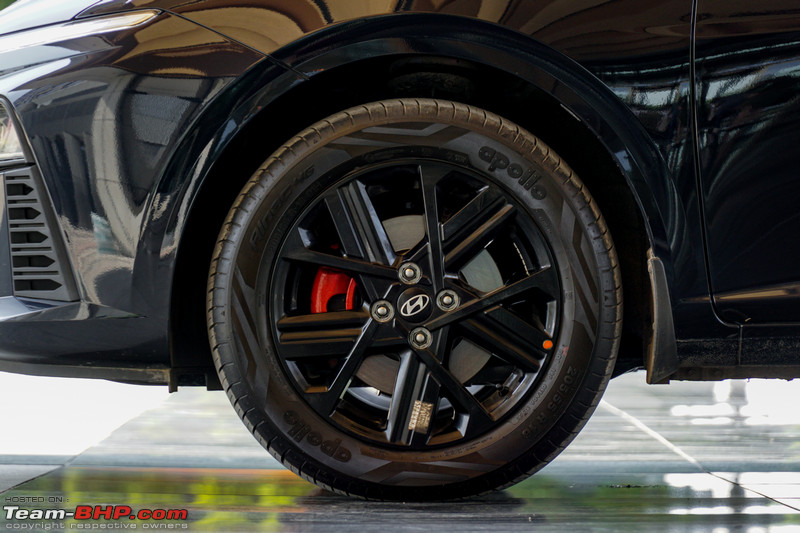 Rear disc brakes are offered only on the top 1.5L turbo-petrol DCT variant. Strangely, the calipers are painted silver. Why not red like the front? 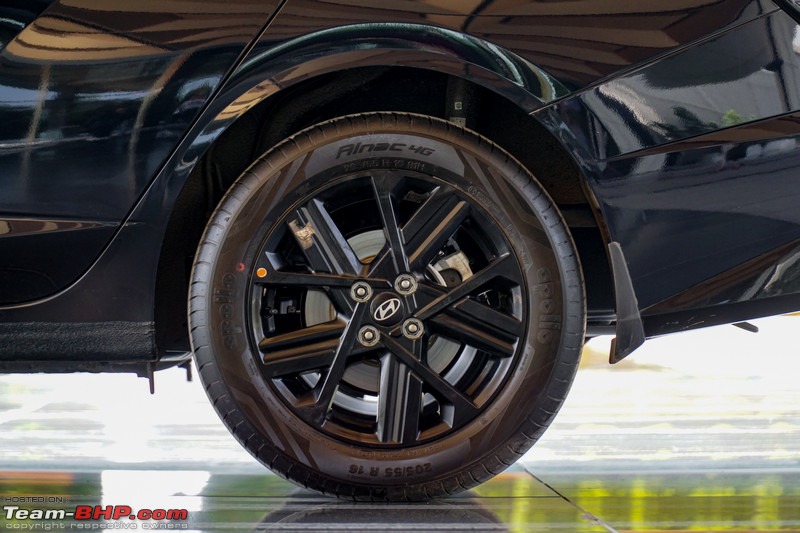 Naturally aspirated variants get 16-inch dual-tone diamond-cut alloy wheels shod with 205/55 section tyres: 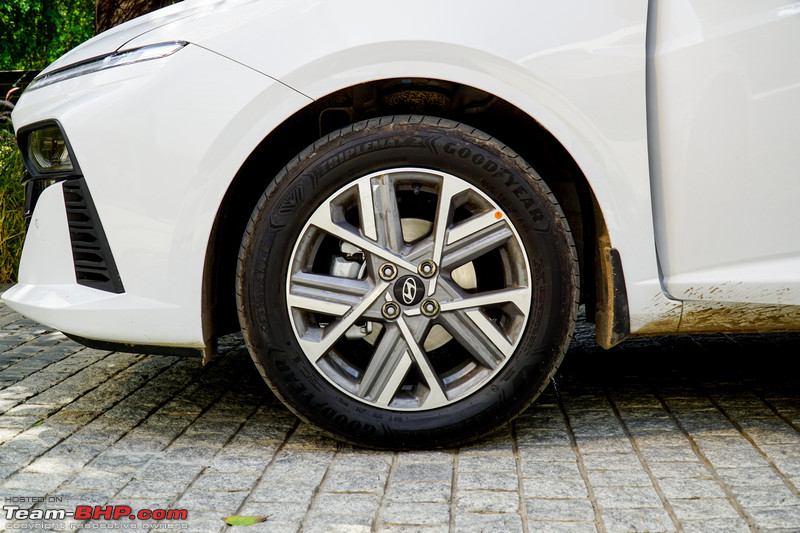 Interesting design element with an upward kink on the C-pillar:  Regular sunroof and a sharkfin antenna at the back. Turbo-petrol variants are available with an optional black roof with the Atlas white and Fiery Red paint shades:  Boot gets a lip spoiler and also an LED light strip running across it. Verna badge is subtle and looks nice: 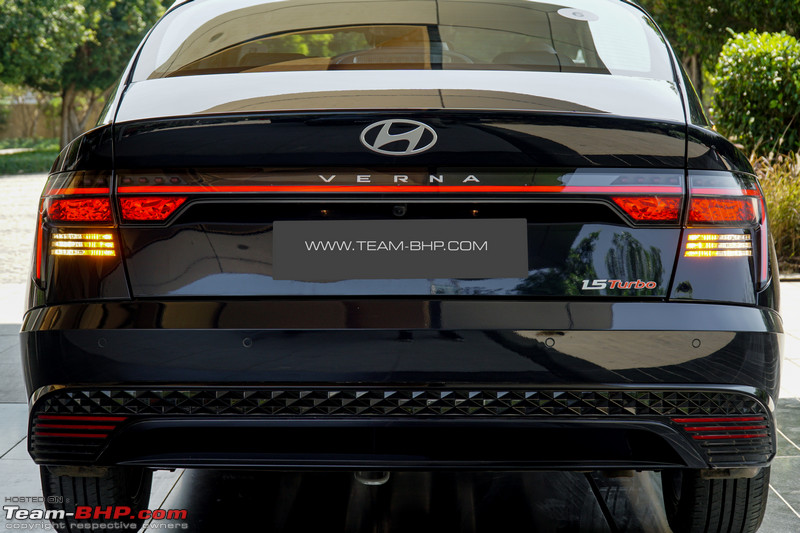 LED tail-lamp cluster has a horizontal T-shaped design and a crystalline finish on the inside. Red dots on the top are the stop lights and the lower portion consists of the pilot light and the reversing light:  "1.5 Turbo" badge sits in the bottom right corner. Chetan thinks the 1.5 is redundant. Just "Turbo" would’ve looked better:  Lower part of the bumper gets checkered detailing along with reflectors on either side. Note the rear towing point at the bottom: 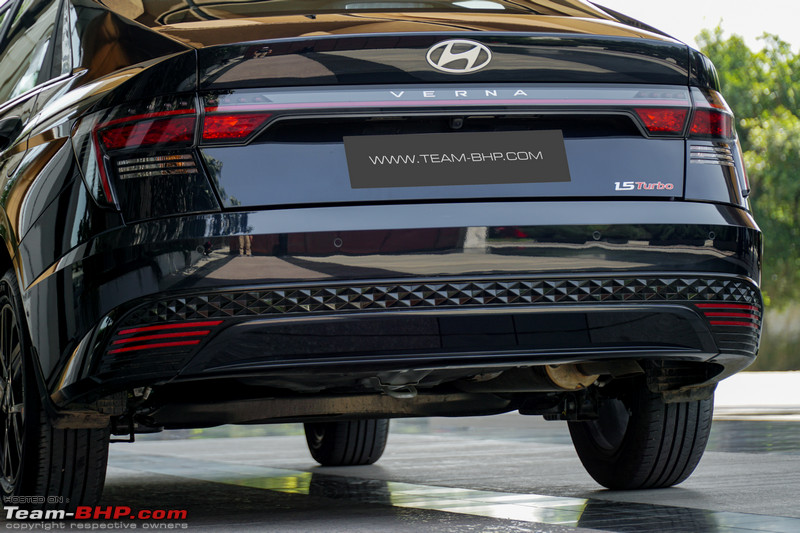 Apart from the Abyss Black colour seen on our test car, the Verna is available in 6 paint shades. Here is the car in Tellurian Brown...  ...Atlas White...  ...Titan Grey… 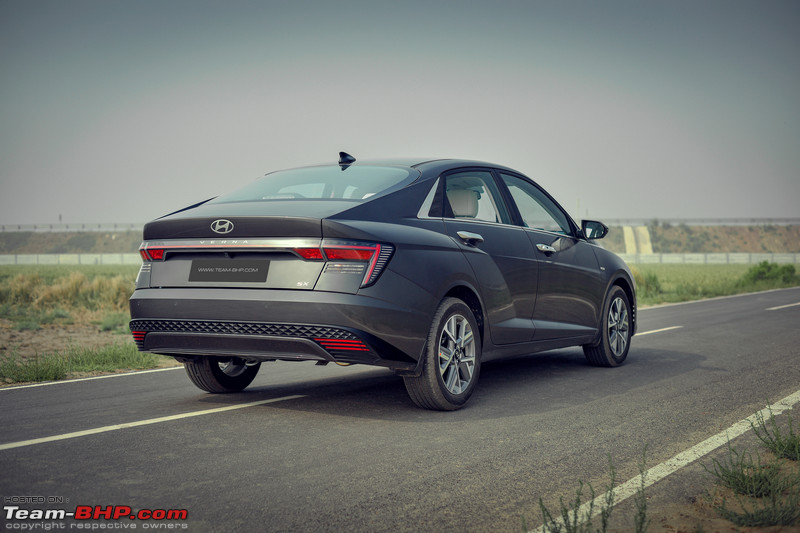 … and Fiery Red. Other colours include Typhoon Silver and Starry Night (a blueish shade):  Last edited by Aditya : 31st March 2023 at 22:47. |
| |  (65)
Thanks (65)
Thanks
 |
| The following 65 BHPians Thank Omkar for this useful post: | aeroamit, AheadAJ, Akshay6988, akshay81, arjunsatheesh, CEF_Beasts, Chetan_Rao, Crazy_cars_guy, dailydriver, digitalnirvana, Dr.AD, espraveen, fluidicjoy, getsurya, Gibence, GTO, gunin, Herschey, InControl, irajput, johy, keroo1099, klgiridhar, libranof1987, Livnletcarsliv, LONG_TOURER, lovetorque, MDED, myavu, Nair.V8, Nazaar25, NitNac, Osteon206, PGNarain, ph03n!x, PM - B, prash1892, PrasunBannerjee, predatorwheelz, RaceCyborg, RavenAvi, rj22, rkv_2401, Roy.S, Rshreyansh, S.MJet, Samba, Samfromindia, sanjayrozario, SanjayW, SatishBisht, Sen, serious_maniac, shancz, Shreyas Aterkar, Simhi, Skyline_GT, stringbh, The Rationalist, TkyoPandaMan, vb-saan, vkivaturi, Voodooblaster, Xaos636, yosbert |
| | #5 |
| Team-BHP Support  Join Date: Apr 2016 Location: Mumbai
Posts: 1,813
Thanked: 21,569 Times
| Hyundai Verna Interior ImagesDashboard design has a fresh feel to it and in this all-black form with red accents looks great: 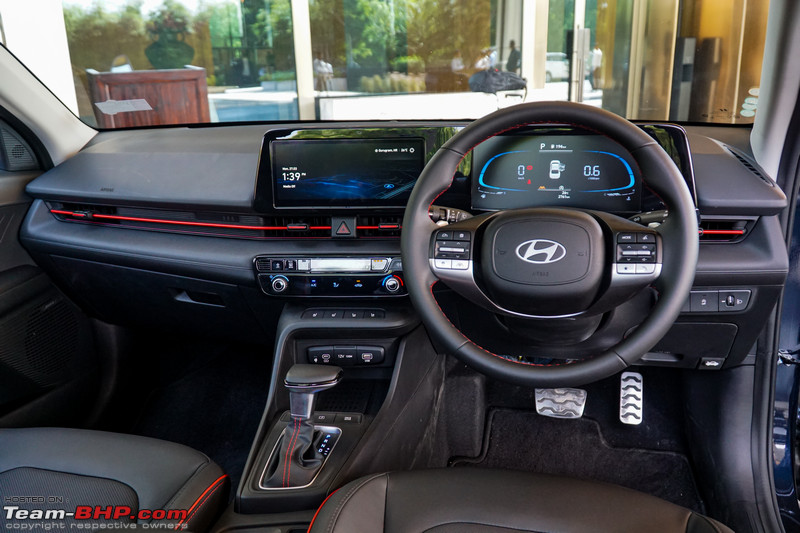 Naturally aspirated variants get a cleaner-looking black and light grey colour scheme: 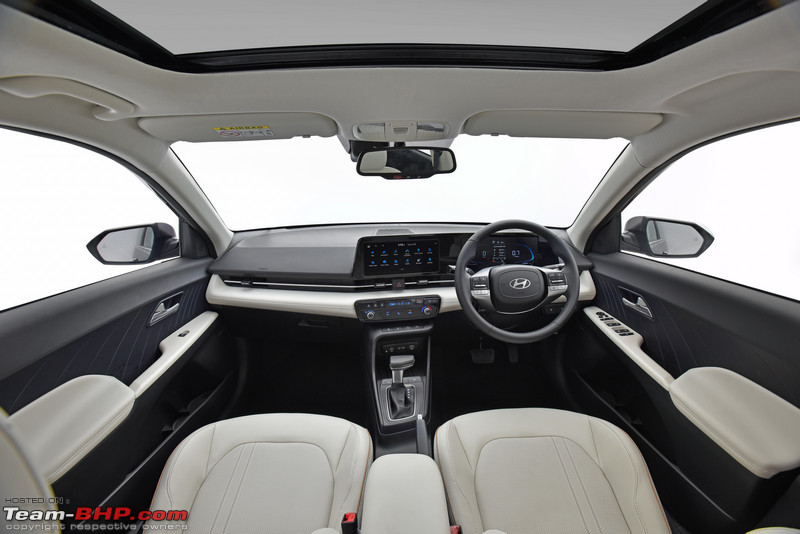 Two-spoke steering wheel isn’t something you’d expect in a Hyundai, but times have changed. I don’t mind the two-spoke design, but Chetan hates this layout. The wheel in itself is good to hold and the thumb contours are comfortable to use as well. The spokes are chunky and have ADAS-related features on the left and telephony controls on the right. While the horn is a pleasant-sounding wind tone unit, the horn pad makes a plasticky click every time you press it. Doesn’t feel premium at all:  Both the automatic variants – DCT and iVT get paddle shifters. These are made of plastic and we wish they were bigger in size:  In typical Hyundai fashion, wiper controls are on the left and light controls are on the right. In an attempt to make the stalks look premium, the rotating knobs on both stalks have been finished in piano black. To some, it might look premium, but IMO, it just attracts fingerprints and would’ve looked cleaner with just one type of material: 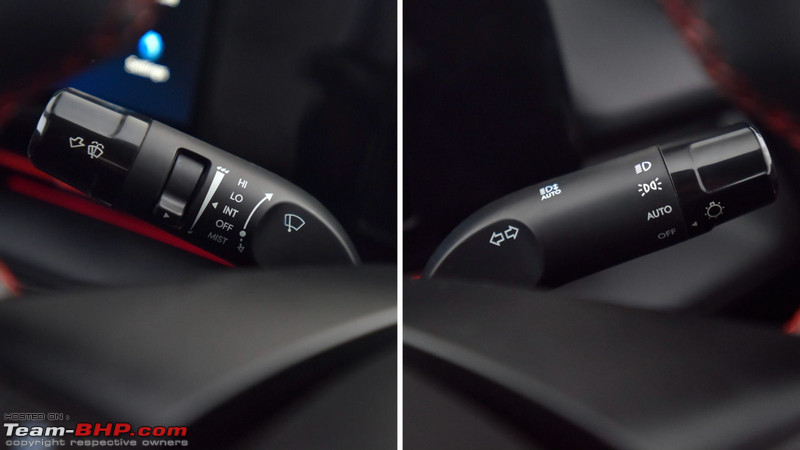 Digital instrument cluster is similar to the Venue facelift. It’s pretty straightforward with the speed displayed on the left and the tachometer on the right in numerical format. However, this is nowhere close to the fully digital instrument cluster you see on the Slavia and the Virtus:  Theme of the instrument cluster changes based on the driving mode selected. MID displays plenty of information related to the ADAS features like lane keep assist, adaptive cruise control, etc.:  We tried out some of the ADAS features on our test drive and some of them worked well when the conditions were ideal. For instance, on the Delhi-Mumbai Expressway, where the lanes were marked properly, the Lane Following Assist worked nicely with the car staying in the middle of the lane and maintaining a safe distance from the vehicle ahead. The system does ask you to keep your hands on the steering wheel for safety. The Blind Spot Collision Warning even detected bikes precisely. We didn’t try out the Smart Cruise Control with Stop & Go in the city as we have a lot of restless drivers/riders on our road to confuse the system:  Sleek horizontal A/C vents get a red accent. Notice the pink line at the bottom of the A/C vent - that’s the Ambient lighting strip. A lot of materials in this area though. On the top left you have the piano black from the instrument cluster, next to it there’s hard plastic, surrounding the A/C vent is the leatherette insert and down below, you again have hard plastic:  Simple-looking engine start-stop button placed on the dashboard:  Traction control and auto start-stop switches have been placed down below. Next to it, you have the manual headlamp leveller. There’s also an automatic leveller that works when the Auto mode is selected for the headlamps:  Doorpads get an all-black treatment. The lines in the area around the door latch are a nice touch: 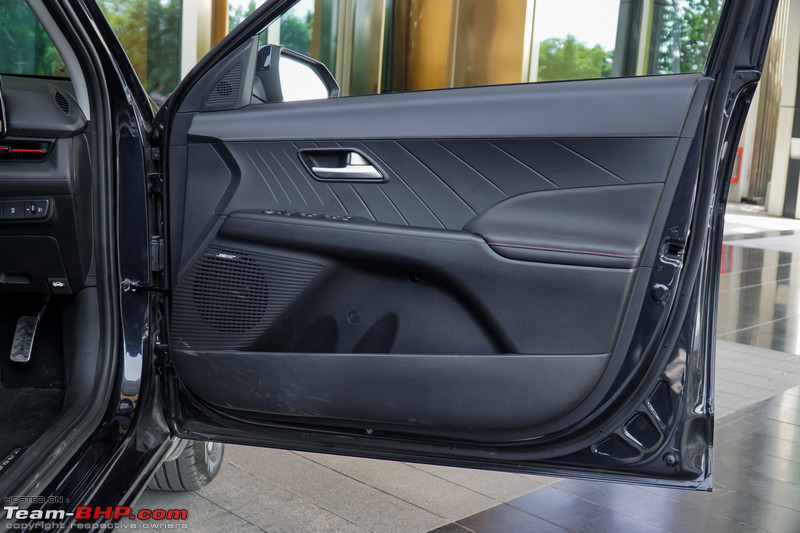 Usual set of window and mirror controls from the Hyundai parts bin:  Door pocket can hold two 500 ml bottles and some other knick-knacks:  Leather-wrapped seats are comfortable and supportive. You can see that the seat bolstering is quite prominent on the backrest as well as the seat base. It helps to keep you in place while cornering to an extent. The cushioning is perfect for long journeys as well as your daily commutes: 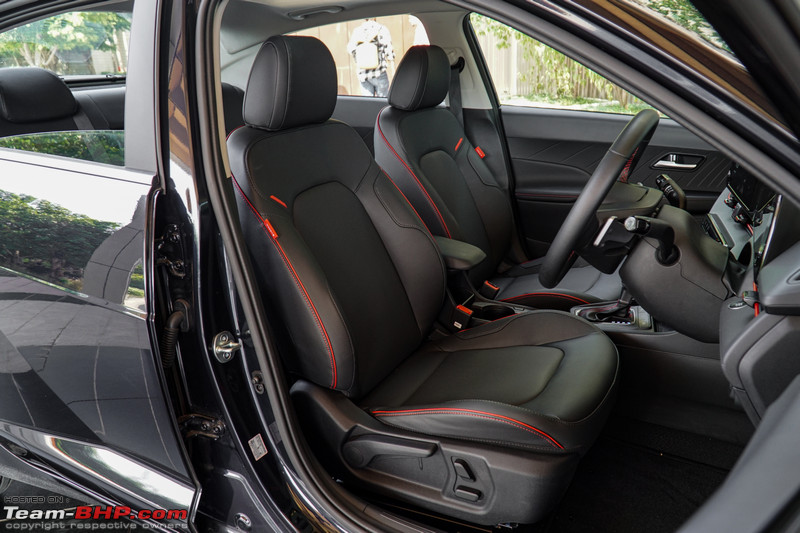 A closer look at the neat detailing on the seat. Even the airbag tag which is usually a cloth label is in leather here with a classy ‘Verna’ label at the back. Very nicely done:  The driver seat gets 4-way electric adjustment and manual height adjustment. Should’ve been electric all the way and some drivers would’ve even appreciated manual lumbar support: 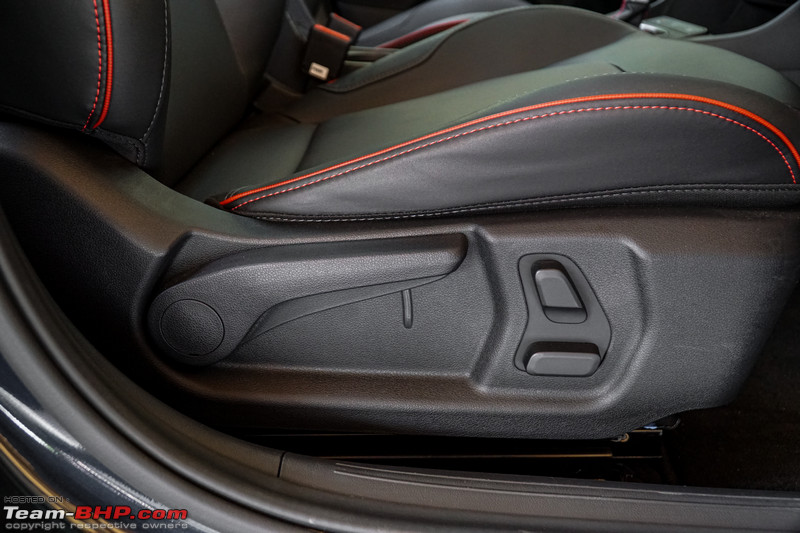 Light grey seat upholstery of the naturally aspirated petrol engine variants. Seats get golden brown contrast stitching: 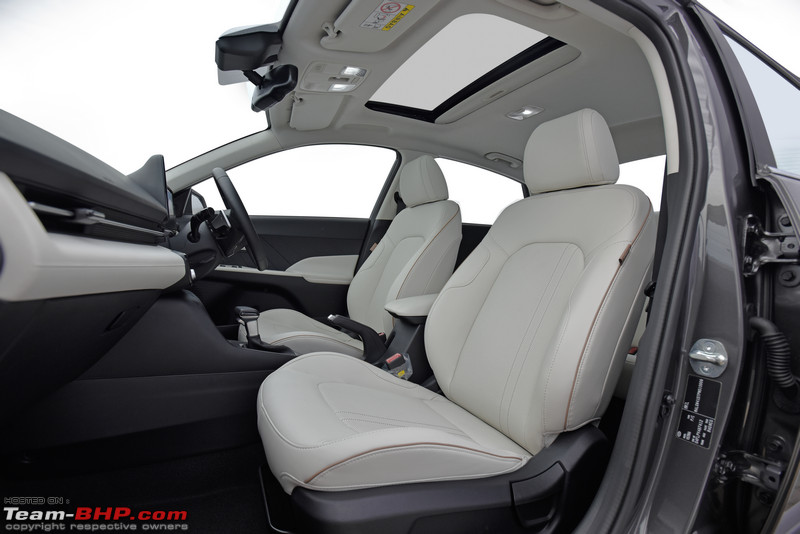 Metal finish for pedals is exclusive to the turbo-petrol variants. They are well spaced out and feel good to use. The dead pedal is just useless. I have a UK10 shoe size and it only covered half of my foot:  Fuel flap release and boot release are placed on the floor:  ORVM provides you with a good view of the action at the rear. It’s sufficiently wide but could’ve been a tad taller. Blind spot alert flashes a red warning triangle in the ORVM:  You get a decent view of the rear from the IRVM considering this is a sedan. But while reversing, you’d be better off using the rear camera:  Like in other Hyundai cars, the auto-dimming IRVM gets 3 buttons - the SOS button will place an emergency call to Hyundai customer care, the button with the tow truck will call Hyundai Roadside Assistance and the third button will launch Blue Link:  Centre console is visibly tilted towards the driver. Ergonomics of the cabin are pretty much spot on and all the controls easily fall to hand:  10.25-inch touchscreen infotainment head-unit gets a piano black border and you have a big shiny surface in between the screen and the instrument cluster which looks quite odd. Hyundai should’ve either separated the two altogether or extended the screen to the instrument cluster. Central A/C vents are similar to the side vents and have a flat design:  Touchscreen has a crisp display and is visible even under direct sunlight. The menu options are well laid out and you can access various ADAS-related features through the touchscreen. It gets wired Android Auto and Apple CarPlay connectivity, onboard navigation and the reversing camera has two viewing angles:  Down below you have a panel with an AC display and few AC controls and two rotary knobs. Hyundai has cleverly integrated AC controls and infotainment controls in the panel between the knobs. You can toggle through the options by pressing the button on the top right. Even the knobs operate different functions depending on the mode that you’ve selected. While it may be a clever integration, it will take some time for people to get used to it. Seat ventilation and heating buttons are placed below:  Wireless charging pad with vertical orientation probably for better visibility while driving. There’s a regular USB port and a USB-C charging port along with a 12V socket:  Just above the gear lever, you have buttons for the parking sensor, reversing camera display and drive modes:  Stylish and premium-looking gear lever. Wide top with piano black and brushed silver finish go well together. Contrast red stitching on the boot makes it look even better. While the gear lever looks classy, the plastics surrounding it feel very average and not premium:  Continuing on the previous point, the plastics here are also not at a level that you would expect in a 20+ lakh rupees car. They’re scratchy and will require cleaning and maintenance at regular intervals. The turbo-petrol DCT variant comes with an electronic parking brake and auto hold. Next to it, you have an open cubbyhole with a retractable cupholder. You can roll up one end into the storage when you want to keep some long items in the storage area and press the ‘Push’ button when you want to use the cupholder:  Adjustable centre armrest is set at a nice height. Adjustment range is limited though:  Electronic parking brake on this turbo DCT variant has freed up a lot of space. Storage area under the armrest does not have a cover, but comes with a removable basket:  Leatherette insert on the dashboard looks and feels nice:  Ambient lighting extends to the doorpad and you can either have it as per the selected driving mode or choose any colour that you like:  Glovebox is medium sized and gets a cooling vent, but no illumination:  Roof bezel houses two individual map lights, sunroof controls and Bluetooth mic:  Sunroof gets a manual sunshade. Rear cabin light is located just behind it:  Rear doorpad also gets an all-black theme. You can squeeze in a 1-litre bottle in the door pocket:  Backrest has a comfortable recline angle. While the middle passenger also gets a 3-point seatbelt, there’s no headrest for him/her: 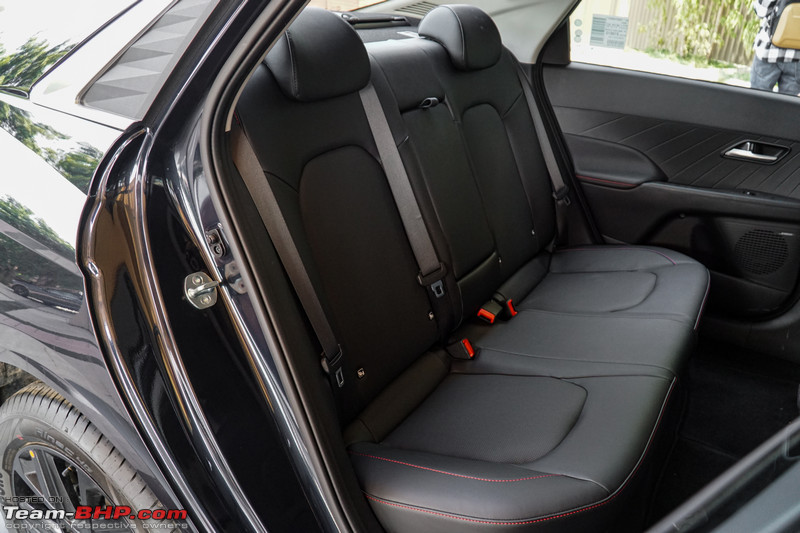 A look at the minimum and maximum legroom available at the rear: 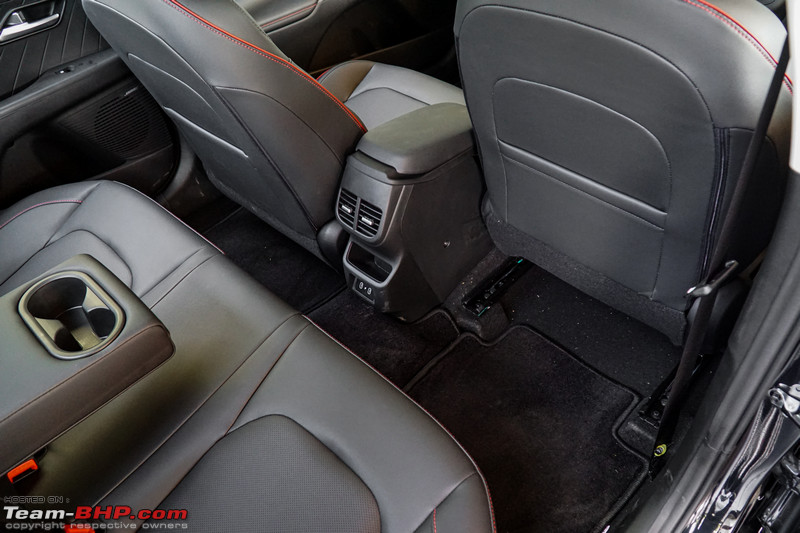 With the front seat adjusted to my driving position, I had enough legroom and knee room as well. At 5’10”, I felt that the under-thigh support could’ve been better. Headroom for 6' tall passengers will be tight:  Centre armrest is at a comfortable height. It is wide and houses two cupholders:  Rear headrests have a very limited adjustment range. They are comfortable to use, but taller users would find them too low even at the highest setting: 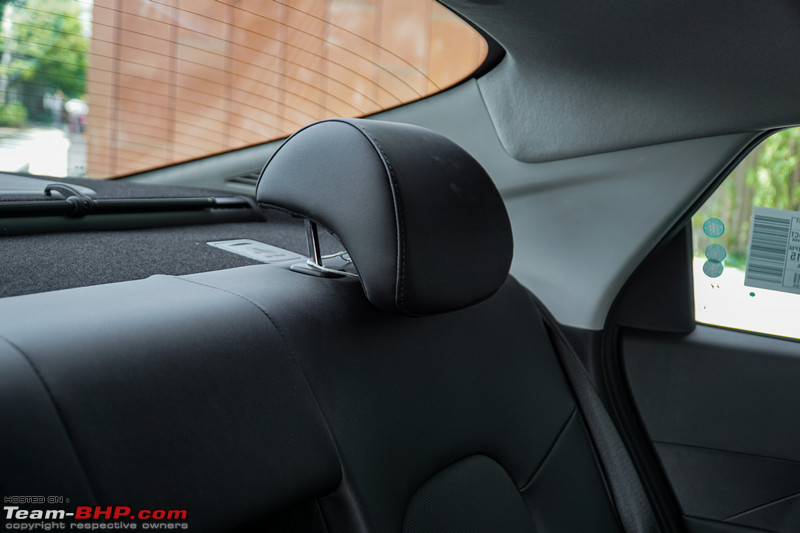 Top tether points for child seat are behind the headrests:  Parcel tray gets a nice cover for the woofer underneath: 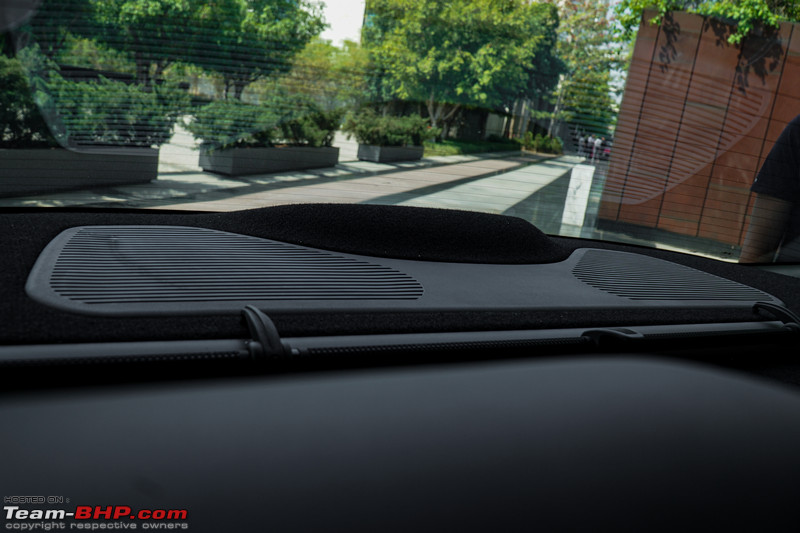 Manual retractable sunshade for rear passengers: 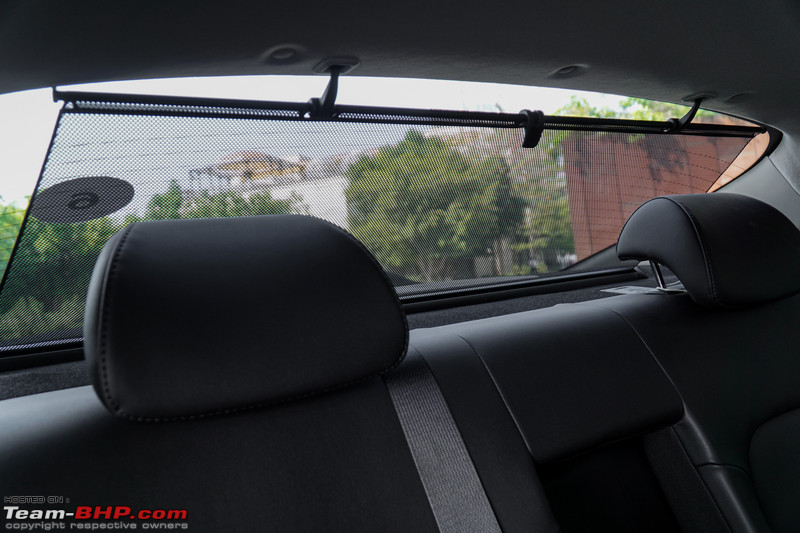 Rear passengers get A/C vents with a phone holder slot below. There are 2 USB-C charging ports. One of them should’ve been a regular USB slot:  Boot space of 528 litres is very usable and is the highest in the segment. The loading lip is at a comfortable height and the mouth is wide enough. Sadly, like the old Verna, you cannot fold the rear seats down to increase the boot capacity or carry long items:  Spare is a 15-inch steel wheel shod with a 185/65 tyre:  Single exposed woofer is a sad sight. A lot of exposed screws and wiring as well:  Last edited by Aditya : 31st March 2023 at 22:49. |
| |  (95)
Thanks (95)
Thanks
 |
| The following 95 BHPians Thank Omkar for this useful post: | aeroamit, AheadAJ, Akshay6988, akshay81, antz.bin, Aquitej, arjunsatheesh, AROO7, ashpalio, aston_martyr, AYP, BhaskarG, bipinbn, catchjyoti, CEF_Beasts, CentreOfGravity, chaksjr, Chetan_Rao, dailydriver, deathwalkr, denzdm, digitalnirvana, docprashant, Dr.AD, Dr.Naren, fiat_tarun, GaryTSI, getsurya, Gibence, GJ01, Grand Tourer, GTO, Harjot37, hiren.mistry, InControl, irajput, jazzrockz, Jeash.vk, johy, keroo1099, Keynote, libranof1987, LONG_TOURER, Maxton07, MDED, MotorDev, myavu, MyLife_MyCar, naadopaasaka, Nazaar25, NitNac, Osteon206, parrymx5, ph03n!x, PM - B, pocketaces, Potenza, PraNeel, prash1892, PrasunBannerjee, Raghu M, Rajeevraj, raptor_diwan, RavenAvi, rj22, rkv_2401, Rohit94AD, Roy.S, Rshreyansh, Samba, Samfromindia, sandeep3764, sanjayrozario, SatishBisht, Sen, Senna_sempre, shancz, Shreyas Aterkar, Silverfire, Simhi, Skyline_GT, somspaple, sourabhzen, stringbh, subie_socal, theexperthand, TkyoPandaMan, TorqueIndia, Tucker48, vb-saan, vignesh207, vivprasad, Voodooblaster, yogiii, yosbert |
| | #6 |
| Team-BHP Support  | Re: 2023 Hyundai Verna Review Thread moved out from the Assembly Line. Thanks for sharing! Last edited by Aditya : 30th March 2023 at 11:04. |
| |  (5)
Thanks (5)
Thanks
 |
| The following 5 BHPians Thank Aditya for this useful post: | Chetan_Rao, digitalnirvana, GTO, SatishBisht, vignesh207 |
| | #7 |
| Senior - BHPian | Re: 2023 Hyundai Verna Review Thanks for the great review. Really sad to hear about the handling characteristics of the car as i was really looking forward to upgrade to this from my t-jet. Would stiffer springs make a difference to correct that? |
| |  (4)
Thanks (4)
Thanks
 |
| The following 4 BHPians Thank deathwalkr for this useful post: | kaushikduttajsr, RaiAnish, Sen, UMXR |
| | #8 | |
| Team-BHP Support  Join Date: Jul 2010 Location: Bangalore
Posts: 5,879
Thanked: 24,039 Times
| Re: 2023 Hyundai Verna Review Quote:
 Hyundai have made the floaty -> neutral transition. Given how different the regular i20 and the N-Line are handling-wise, we hope a Verna N-Line will finally make the jump from neutral -> sporty. Powertrain: Check. Chassis: TBD. Last edited by Chetan_Rao : 30th March 2023 at 13:49. | |
| |  (30)
Thanks (30)
Thanks
 |
| The following 30 BHPians Thank Chetan_Rao for this useful post: | 2himanshu, Akshay6988, AROO7, deathwalkr, digitalnirvana, espraveen, GaryTSI, gauravanekar, InControl, johy, keroo1099, Keynote, Mu009, Nitish B Shetty, oakajale, ohaak, prash1892, PrasunBannerjee, RaiAnish, rajvardhanraje, rj22, romil.shroff, ryzen7@5800u, sai_ace, Sen, shyampsunder, Silverfire, SRISRI_90, theexperthand, YashD |
| | #9 |
| Senior - BHPian Join Date: Mar 2020 Location: Pune
Posts: 1,468
Thanked: 4,185 Times
| Re: 2023 Hyundai Verna Review Exhaustive review as usual. Thank you! Few queries- WRT Competition (Just a suggestion, for future reviews make this a standard, where the car is rated in terms of parameters against the competition)- How much would you rate the competition (VW-Skoda and Honda) and Verna out of 10 in the following criteria- Acceleration Handling Low speed ride quality High speed ride Rear interior space and comfort Interior quality Gearbox NVH WRT to Verna- 1) Is there ambient lighting in the rear? 2) Does the instrument console even provide navigation directions? Last edited by 07CR : 30th March 2023 at 11:55. |
| |  (2)
Thanks (2)
Thanks
 |
| The following 2 BHPians Thank 07CR for this useful post: | epiccross, Voodooblaster |
| | #10 | |||
| BHPian Join Date: Sep 2022 Location: Nagpur
Posts: 46
Thanked: 112 Times
| Re: 2023 Hyundai Verna Review Excellent review. I'd rate it 100/100. (OT: I'd like to rate this thread 5 stars - is it too presumptuous of me to do so as a newbie?) Quote:
 The potent turbo-petrol and DCT seem like the ideal combination for a road-trip car! Regarding the understeer, will better rubber alleviate the problem? Quote:
Like how we see ECU tuners in India, I wonder if a new segment of tuners will develop for electric power steering tuning - looks like some parameters of the steering assist can be changed on-the-go! Quote:
One grouse I had with our Nexon is the extremely slippery cloth material used in the XE trim - I hope the leather used in the Verna is grippier. Similarly, it's rear bench is far too reclined for comfort - and it's not adjustable. Is the Verna's rear bench adjustable in any way - can any aftermarket solution be used for adjustment? Are there grab handles for all passengers? All things considered - the new Verna (especially the DCT-Turbo variant) seems like an excellent jack-of-all trades. If it gets a decent NCAP rating, it's the ideal replacement for our Nexon. | |||
| |  (4)
Thanks (4)
Thanks
 |
| The following 4 BHPians Thank ryzen7@5800u for this useful post: | InControl, jeepster_chd, MDED, Voodooblaster |
| | #11 |
| Senior - BHPian | Re: 2023 Hyundai Verna Review Great review! Did you get a chance to try out the turbo MT? Would like to know how is the shift quality, long throw v/s short throw etc. On the thigh support or lack of it, is it perhaps because you are sitting lower in the Verna than the Virtus? Also given the extra leg room, does stretching out your leg give a better thigh support? Thanks, Shibu. |
| |  (1)
Thanks (1)
Thanks
 |
| The following BHPian Thanks shibujp for this useful post: | ryzen7@5800u |
| |
| | #12 |
| BHPian Join Date: Nov 2022 Location: New Delhi
Posts: 283
Thanked: 1,039 Times
| Re: 2023 Hyundai Verna Review Excellent review, as always.  Quick question - Does TPMS also show the tyre temperature? |
| |  ()
Thanks ()
Thanks
 |
| | #13 | ||||
| Team-BHP Support  Join Date: Jul 2010 Location: Bangalore
Posts: 5,879
Thanked: 24,039 Times
| Quote:
Powertrain: 1.5 TSi DSG > 1.5 TGDi DCT > 1.5 iVTEC CVT ~ 1.5 MPi IVT Handling: VAG Twins > Hyundai > Honda Ride: VAG Twins > Hyundai ~ Honda Space: Honda > Hyundai > VAG Twins NVH: Hyundai > VAG Twins > Honda Gearbox: DSG > DCT > IVT > CVT Interiors: VAG Twins > Honda > Hyundai (If Hyundai swapped the scratchy plastics for better material, I'd rate Hyundai higher. The cabin LOOKS great, the plastics dilute the FEEL, esp. in the black + red cabin). Quote:
'You sure? Yup. Ok, hang tight!' Quote:
 . .Quote:
Solid NVH (sweet motor, plus wind & tire noise control), ideal family cruiser than can be a bit fun too. Last edited by Chetan_Rao : 30th March 2023 at 12:22. | ||||
| |  (34)
Thanks (34)
Thanks
 |
| The following 34 BHPians Thank Chetan_Rao for this useful post: | 07CR, Akshay6988, arjunsatheesh, ashivas89, digitalnirvana, espraveen, GaryTSI, gauravanekar, gopi_rm, InControl, Jeevith, JojyKerala, lovetorque, myavu, MyLife_MyCar, Nitish B Shetty, oakajale, pocketaces, prash1892, RaiAnish, Rajeevraj, rajvardhanraje, rj22, rkv_2401, ryzen7@5800u, Silverfire, Simhi, SRISRI_90, stringbh, TDIRaghav, TechnoBloop, tsi_niks1989, Voodooblaster, yesyeswe |
| | #14 | |
| Senior - BHPian | Re: 2023 Hyundai Verna Review Quote:
0-100kph of 8.1 seconds with the Turbo GDI engine is the real deal  Last edited by clevermax : 30th March 2023 at 12:29. | |
| |  (3)
Thanks (3)
Thanks
 |
| The following 3 BHPians Thank clevermax for this useful post: | deathwalkr, gauravanekar, sai_ace |
| | #15 | |
| Team-BHP Support  Join Date: Jul 2010 Location: Bangalore
Posts: 5,879
Thanked: 24,039 Times
| Re: 2023 Hyundai Verna Review
We wanted to, but there just wasn't time. Multiple cars on a single day will just end up with no proper review on any. We did get a very short spin in the 1.5 MPi IVT; smooth, peppy in low & mid range, and no rubber banding. Sounds sweet when revved too! Quote:
Last edited by Chetan_Rao : 30th March 2023 at 12:34. | |
| |  (7)
Thanks (7)
Thanks
 |
| The following 7 BHPians Thank Chetan_Rao for this useful post: | ashivas89, digitalnirvana, gauravanekar, InControl, prash1892, shibujp, Voodooblaster |
 |





